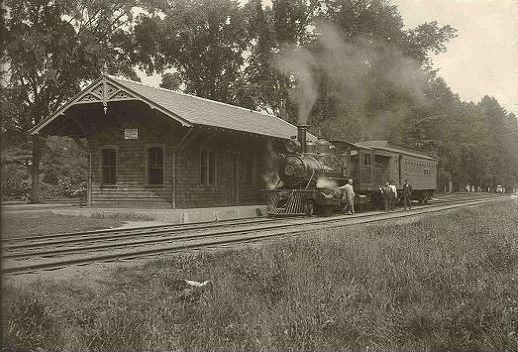 | ||
The South Manchester Railroad (SMRR, also known as the Cheney Railroad or Cheney's Goat) was a short-line railroad, operating in Manchester, Connecticut. It was in operation from 1869 to the 1980s.
Contents
History
The incorporation of the railroad occurred on 30 May 1866, and three years later, the Cheney brothers (known at the time for their success in the silk industry) finished construction. When finished, the two-mile long railroad was the only line in the United States to be owned by a family rather than a company. It was used as a method to send silk products from their mill in Manchester to the other mill, based in Hartford. Some of the workers also used the rail as a way to get to the mills for a low fare, but most lived in houses located on the property.
In 1914 an innovative collision prevention device was successfully tested on the South Manchester Railroad after president Mollen had offered a prize to the inventor of a device that would automatically stop trains who approached each other on the same track. The rail track was wired, and a system of batteries was attached to the locomotive, which threw over the throttle, applied the air brakes and thus stopped the train, when the axles of another train produced an electrical short cut between the rails.
The railway provided its services not only to Cheney's employees. For instance, it was used by students from the South End to travel to Hartford Public High School, before Manchester High School was built in 1904. It transported theatergoers to Cheney Hall, and businessmen to the silk shows there. The train also ran on Sundays taking people to the Catholic church at the north end and the schedule was irregular, depending on the time the priest set for masses. On special occasions, up to 3500 passengers per day, paid ten cents a trip. The railway also transported coal to paper mills in the south end of town, as well as farm produce and supplies from south to north.
During the Great Depression in the 1930s, the Cheney brothers began to sell most of their assets. The railroad was part of their liquidation. The final passenger trip occurred in 1933, while freight was delivered through the years until the 1980s.
Accidents
After a passenger had left the train near the Hilliard street bridge at the North End, he walked off the trestle and fell onto to the road beneath. When conductor rushed to help him, the man got up uninjured and just exclaimed: "Where am I, anyway?"
At least two fatal accidents occurred, where both victims were drunk. The first victim was hit near the Middle Turnpike crossing. He was only noticed on the return trip and died shortly after being found. His pint bottle of liquor resting against the track was not even broken. The other fatal accident occurred on the embankment near the Center Springs pond.
Another man who was hit by the train was taken to his home in a sleigh, and when the traffic superintendent Richard O. Cheney visited him later, he apologized for getting in the way of the train. He recovered, and, allegedly, did not drink another drop of intoxicating liquor again.
A musician got once entangled in the double bass, when the coach, in which he and some of his colleagues were riding, derailed, because a wheel had come off the train. On another occasion, a man flagged the train at Middle Turnpike and asked that Richard O. Cheney should be notified that his bull had escaped from his meadow and was on someone else's property.
South Manchester Railroad Station
The station was built in 1879, with its purpose being for freight and general use. It was located at the corner of Park Street and Elm Terrace.
Locomotives
A 0-4-4 steam locomotive named 'Mt. Nebo' was supplied in 1879 by Baldwin Locomotive Works in Philadelphia, PA. It was designed and patented by Matthias Nace Forney for hauling both freight and passengers.
Present-day
In 2005, one mile of the railroad was purchased by the Manchester Land Conservation Trust. The route is a pedestrian path, known as the Cheney Rail Trail. A part of the track is still in existence and is in operation.
